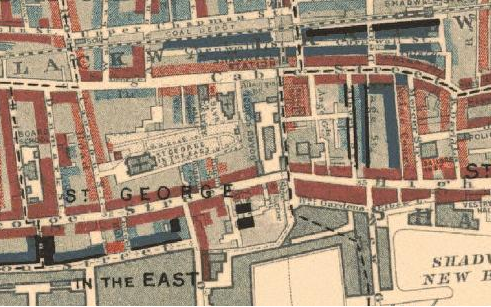Blue Gate Fields in Oscar Wilde’s novel The Picture of Dorian Gray becomes the pivotal moment in the novel where Dorian’s soul is eternally damned with corruption. The essence of Blue Gate Fields is located in an area deriving of low middle class, poverty stricken people, and vicious criminals as depicted in the Booth Poverty online archive. An area where Basil would color as a place that vile creatures lived, and it becomes an area in which Dorian yearns for. The descent into Blue Gate Fields begins in Chapter 11 where the narrator explains Dorian’s affliction with becoming a denizen of the decrepit East London location: “Then, suddenly, some night he would creep out of the house, go down to dreadful places near Blue Gate Fields, and stay there, day after day, until he was driven away” (Wilde). The use of the word “suddenly” becomes a defining characteristic of the nature of Dorian’s descent into West London and the corruption affiliated with the area. For a man defined as “pure” on the outside stalking about in the most wretched of places “suddenly” exposes the ways in which Dorian himself can slip versatilely between aristocracy and the criminal squatters of Blue Gate Fields on a whim.
 Later on in the novel we find that Dorian frequents Blue Gate Fields for its opium dens. In Chapter 16, the corruption of Dorian’s soul becomes exploited through the means of obtaining opium to blissfully ebb away the insidious sins that he had committed over the years: “There were opium dens where one could buy oblivion, dens of horror where the memory of old sins could be destroyed by the madness of sins that were new” (Wilde). The area surrounding Cable street (the real name of the notorious Blue Gate Fields) that Dorian frequents for its opium dens harbored many violent thefts, sexual offences, and cases of deception. The narrator describes the area in which Dorian runs around as “a dark lane. Over the low roofs and jagged chimney-stacks of the houses rose the black masts of ships. Wreaths of white mist clung like ghostly sails to the yards” (Wilde). Despite the fact that the harbor is relatively further away than Wilde depicts, the area near water is the defining characteristic that brings the opium den’s realistic nature to fruition.
Later on in the novel we find that Dorian frequents Blue Gate Fields for its opium dens. In Chapter 16, the corruption of Dorian’s soul becomes exploited through the means of obtaining opium to blissfully ebb away the insidious sins that he had committed over the years: “There were opium dens where one could buy oblivion, dens of horror where the memory of old sins could be destroyed by the madness of sins that were new” (Wilde). The area surrounding Cable street (the real name of the notorious Blue Gate Fields) that Dorian frequents for its opium dens harbored many violent thefts, sexual offences, and cases of deception. The narrator describes the area in which Dorian runs around as “a dark lane. Over the low roofs and jagged chimney-stacks of the houses rose the black masts of ships. Wreaths of white mist clung like ghostly sails to the yards” (Wilde). Despite the fact that the harbor is relatively further away than Wilde depicts, the area near water is the defining characteristic that brings the opium den’s realistic nature to fruition.
Blue Gate Field’s location in the story also allows for the altercation between Dorian and James Vane to take place with the gun and the threat to Dorian’s life. The violent nature of Dorian’s sins and James’s intent of murdering Dorian to avenge his departed sister is consumed within the Eastern part of London as a way to condemn these two characters who are corrupted: one with vengeance, the other with insatiable desire for beauty and a painting that encapsulates it.
_______________
Works Cited:
“Booth Poverty Map & Modern Map (Charles Booth Online Archive).” Booth Poverty Map & Modern Map (Charles Booth Online Archive). N.p., n.d. Web. 16 Dec. 2015.
“The Picture of Dorian Gray (1891)/Chapter 11 and 16.” – Wikisource, the Free Online Library. N.p., n.d. Web. 16 Dec. 2015.
“The Proceedings of the Old Bailey.” Browse. N.p., n.d. Web. 16 Dec. 2015

Being ahead of the project is awesome. Admiring the time and effort you put into this project and in depth detil info you put into it.
http://telkomuniversity.ac.id